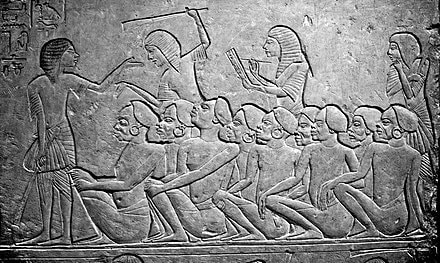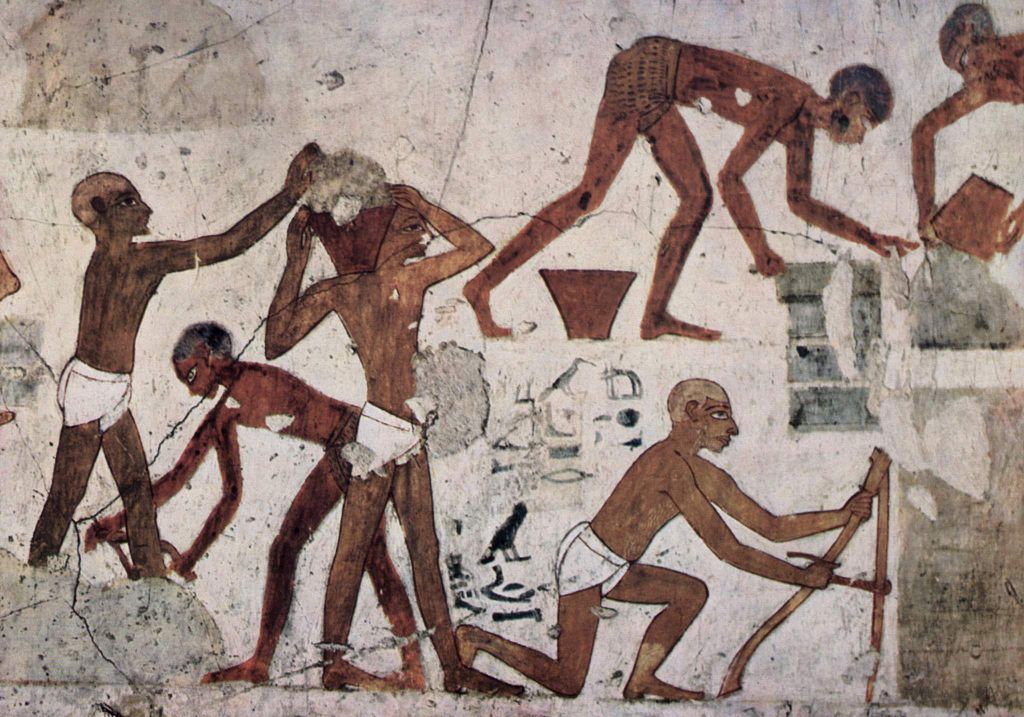Last updated on April 6th, 2023 at 10:21 pm
What was it like to be a slave in ancient Egypt? This is a question that historians have asked for many years, but we may never honestly know the answer.
However, we know what life was like for slaves based on what we can learn from ancient texts and archaeological evidence.
Enslaved people in ancient Egypt were used for various tasks, including construction, farming, and household work.
So, what was their daily life like in ancient Egypt? What did enslaved people do all day? In this blog post, we will explore the life of an enslaved person in ancient Egypt and try to answer these questions.

Slave Life In Egypt Wasn’t As Hard As We Think
Research supports the idea that slave life in ancient Egypt wasn’t near as bad as we assumed. An excellent example of this concerns the building of the pyramids.
It was a long-held belief in science that oppressed slaves built these pyramids and were subjected to horrible working conditions. However, a recent study found that most workers who built the pyramids were paid laborers, not slaves.
Furthermore, according to Dr. Andrzej Cwiek, an Egyptologist from the Archaeological Museum in Poznan, pyramids and other monumental royal structures were built by skilled and highly-qualified workers.
These workers would have devoted their entire lives to the cause. While that doesn’t mean that there was no forced labor in the society, it does mean that there is no archaeological evidence that supports the notion that the slaves were subjected to consistent back-breaking work.
It seems that the slave population consisted of prisoners of war, usually foreigners. Dr. Cwiek mentions that the population of slave workers swelled during the Imperial Period (1550-1069 BC) due to several successful campaigns. These individuals would have been of Asian, Nubian, and Syro-Palestine descent.
Despite these conquests, the economy in Egypt was never based on slavery as in other ancient civilizations, like Rome. Instead, records indicate that the slave class wasn’t necessarily separate from the free class, and if a slave could buy their freedom, they would be assimilated into society.

In other words, Egyptian life wasn’t dependent on their contributions and would move on without them if the foundations of society required it. Dr. Cwiek also mentions that slave life didn’t have to be any harder than any other Egyptian performing necessary work in the community. If their lives weren’t bound in, then how did they live?
Slaves In Ancient Egypt Could Assimilate
In ancient Egyptian society, slaves were often treated like other workers. While these workers didn’t have the freedoms that the upper class did, they were often highly-skilled workers with in-demand skills.
What was fascinating about ancient Egyptian society was that the slaves could assimilate into society quite easily. Their social status wasn’t stigmatized in the way it was in other cultures and civilizations.
An excellent example of their privilege is the idea that they weren’t seen as a separate social group despite the distinction. Often slaves voluntarily gave up their freedoms due to debt, their criminal history, or were prisoners of war.
Although their legal status wasn’t clear, they were still treated like ordinary citizens and even had access to owning private property. Dr. Cwiek also says that there were even cases of slaves marrying Egyptian women, which were said to have equal rights to men in ancient Egyptian society.
Archaeological evidence supports the idea that slaves were treated like average workers. For instance, the craftsman that built the pyramids often had to source stone blocks for building materials.
Slaves were sent to these teams of stone workers to assist in the process, but it doesn’t appear that they were ill-treated or forced into inhumane conditions. They also worked closely with the craftsman as private servants in their homes in Deir el-Medina, a village of workers that built the tombs in the Valley of Kings near Luxor.
It makes sense that the working-class craftsman and the slaves were treated the same because neither could move freely around the country. Usually, both individuals had strict social roles and were expected to perform their duties; if anything, this comprised the social structure of ancient Egyptian civilization.
Asian and Nubian Society Were Negatively Viewed
While there wasn’t a clear social divide between the slaves and citizens in Egypt, it’s important to note that Egyptians looked down on other cultures and societies. Asians and Nubians were said to have a negative reputation in the ancient Egypt.
Researchers could speculate the reasoning behind this, but once these individuals were enslaved into Egyptian culture, they were treated exceptionally well. Compared to other cultures, the Egyptians didn’t treat slaves like prisoners.
These individuals adjusted quite well to Egyptian society, learned the language, and often married Egyptian women. Their ability to change into model Egyptian citizens often led to fantastic opportunities for slaves.
Great Careers Were Also Possible For Slaves
While slaves enjoyed jobs and responsibilities like all other working-class members, there were unique cases where they achieved something more extraordinary. For example, Mai-per-heri lived during the 15th century BC and was of Nubian descent.
Despite his heritage, he was buried in the Valley of Kings. His name, “Lion on the battlefield,” suggests that he could have had a great career in the Egyptian military or saved the life of a Pharaoh.
Slaves Could Earn Their Freedom
Like in other cultures, slaves in ancient Egyptian society could earn their freedom. Emancipation could come in a couple of different ways depending on the situation. For instance, slaves could earn their freedom by adoption, where owners adopt the children of their adult slaves.
Another method was the idea that enslaved people could be “swabbed” by the king and purified. This path would eventually lead to an opportunity for enslaved people to earn wages, have rights, marry, start families, and even keep their original names.
Slavery in Ancient Egypt
While slavery is often viewed as a negative aspect of ancient Egyptian society, it’s important to remember that the treatment of slaves depended on their social status.
Most slaves were treated exceptionally well, given the opportunity to learn a trade and earn their freedom.
It’s believed that this was because society needed enslaved people to construct ancient Egyptian monuments and temples and participate in agricultural work.
In general, slaves were an essential part of ancient Egyptian society but not foundational to its existence; however, they did help contribute to its success.


The latin word for “slave” was “servantes”, from which we get “servant,” one who serves. We still use this term, and its connotation of social standing.